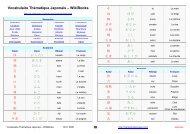Algorithm Finder Lite - mementoslangues.fr
Algorithm Finder Lite - mementoslangues.fr
Algorithm Finder Lite - mementoslangues.fr
You also want an ePaper? Increase the reach of your titles
YUMPU automatically turns print PDFs into web optimized ePapers that Google loves.
Variables<br />
There is a maximum of 8 variables that can be used in <strong>Algorithm</strong> <strong>Finder</strong> <strong>Lite</strong> (AFL):<br />
Variables are of 3 types:<br />
X, Y, Z, P, Q, A, E, G<br />
1- Basic moves: X, X', Y, Y', Z, Z', P, P', Q, Q', A, A', E, E', G, G'<br />
Examples:<br />
X = R → X' = R'<br />
Y = NU' → Y' = NU<br />
Z = N3F2 → Z' = N3F2<br />
2- Opposed moves: Xo, Xo', Yo, Yo', Zo, Zo', Po, Po', Qo, Qo', Ao, Ao', Eo, Eo', Go, Go'<br />
Examples:<br />
X = R → Xo = L, Xo' = L'<br />
Y = NU' → Yo = ND', Yo' = ND<br />
Z = N3F2 → Zo = N3B2, Zo' = N3B2<br />
3- Symmetric moves: Xs, Xs', Ys, Ys', Zs, Zs', Ps, Ps', Qs, Qs', As, As', Es, Es', Gs, Gs'<br />
Examples:<br />
Symmetry: F – B Axis (CF2)<br />
X = R → Xs = L, Xs' = L'<br />
Y = NU' → Ys = ND', Ys' = ND<br />
Z = N3F2 → Zs = N3F2, Zs' = N3F2<br />
Using variables of opposed moves or symmetric moves together with variables of basic moves will save much<br />
computation time, because they do not need additional for loops.<br />
Semi-Commutators<br />
Semi-commutators are commutator-like expressions where the ordering of moves has been reversed, depending<br />
on the direction of the closing bracket(s):<br />
[XY, ZP] = XY·ZP·Y'X'·P'Z' (commutator)<br />
[XY, ZP[ = XY·ZP·Y'X'·Z'P' (semi-commutator)<br />
]XY, ZP] = XY·ZP·X'Y'·P'Z' (semi-commutator)<br />
]XY, ZP[ = XY·ZP·X'Y'·Z'P' (semi-commutator)<br />
For a given number of variables, semi-commutators may give solutions where commutators would give none.<br />
Symmetric Commutators<br />
Knowing that a cube has a set of 48 symmetries, we can further expand the concept of 'plain' commutator [A, B]<br />
to the 'symmetric' commutator, where the inverses of A and B are replaced with As and Bs, being the inverses of<br />
their respectives transformations by any of the 48 cube symmetries, that is:<br />
[A, B]s = [X Y, Z P Q]s = X Y·Z P Q·Ys' Xs'·Qs' Ps' Zs' = (X Y)·(Z P Q)·(Xs Ys)'·(Zs Ps Qs)' = A·B·As'·Bs'<br />
In this notation, subscript 's' indicates that symmetry has been applied to the the second half of the expression.<br />
A plain commutator is then just a particular case of a symmetric commutator, for which the applied symmetry is<br />
simply the 'Identity' symetry:<br />
F→F<br />
R→R<br />
U→U<br />
L→L<br />
D→D<br />
B→B<br />
<strong>Algorithm</strong> <strong>Finder</strong> <strong>Lite</strong> 3/37 http://www.<strong>mementoslangues</strong>.<strong>fr</strong>/ <strong>Algorithm</strong> <strong>Finder</strong>

















